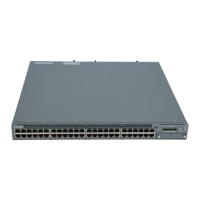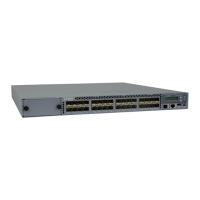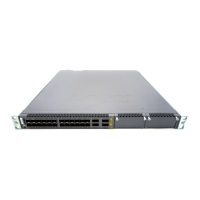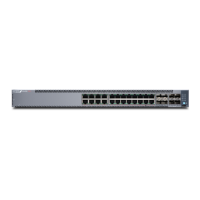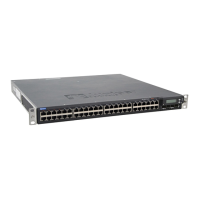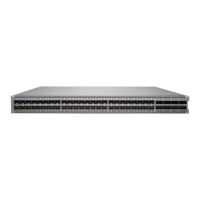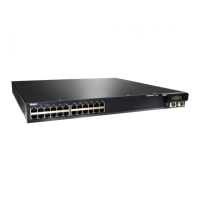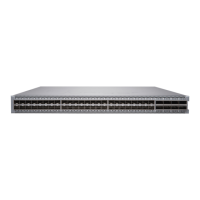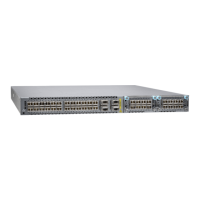
Do you have a question about the Juniper EX4300 Series and is the answer not in the manual?
| Product Series | EX4300 Series |
|---|---|
| Power Consumption | Varies by model and configuration |
| Virtual Chassis Technology | Up to 10 switches |
| Software | Junos OS |
| Ports | 24-port and 48-port models |
| 10GBASE SFP+ Ports | Up to 8 ports |
| 40GBASE QSFP+ Ports | 2 |
| Uplink Ports | Up to 4 ports |
| Jumbo Frames | Up to 9216 bytes |
| Operating Temperature | 0°C to 45°C |
| Relative Humidity | 5% to 90% noncondensing |
| Input Voltage | 100 to 240V AC |
| Power Supply | AC or DC |
| Power Supply Options | AC or DC |
| Stacking | Yes |
| Layer 2 Features | Includes VLAN, STP, RSTP, MSTP, LACP |
| Layer 3 Features | OSPF, BGP |
| Management | CLI, Web GUI, SNMP |
| Security Features | DHCP snooping |
| QoS | 8 queues per port, DSCP |
| Storage Temperature | -40°C to 70°C |
Provides a general overview of the EX4300 switch's capabilities and features.
Details the physical hardware components and architecture of the EX4300 switches.
Describes the specifications and components of the 24-port EX4300 switch models.
Details the specifications and components for the 32-port EX4300 switch models.
Outlines the specifications and components of the 48-port EX4300 switch models.
Explains how to identify the specific model number of an EX4300 switch.
Provides detailed physical dimensions and weight specifications for the EX4300 chassis.
Identifies components that can be replaced in the field without powering off the switch.
Covers various aspects of the EX4300 switch chassis, including panels and LEDs.
Explains the cooling system, fan modules, and airflow directions for EX4300 switches.
Covers the power system, including AC and DC power supplies and their configurations.
A checklist of tasks for preparing a site for EX4300 switch installation.
Outlines environmental, site, rack, and cabinet requirements for EX4300 switches.
Guides planning for network cables and transceivers for EX4300 switches.
Lists supported transceivers and provides compatibility information for EX4300 switches.
Provides specifications and pinout information for management cables.
Provides step-by-step instructions for unpacking and mounting the EX4300 switch.
Guides the user through connecting AC and DC power, including grounding.
Explains how to connect the switch to management devices and networks.
Covers connecting the switch to the network, including transceivers and cables.
Explains how to connect QFX and EX series switches into a QFX Virtual Chassis.
Covers the process of configuring Junos OS on the EX4300 switch.
Covers procedures for maintaining the switch's cooling system, including fans.
Details procedures for maintaining the switch's power supplies, including AC and DC.
Covers procedures for removing and installing uplink modules.
Covers procedures for removing and installing transceivers.
Covers procedures for connecting, disconnecting, and handling fiber-optic cables.
Covers various troubleshooting steps for EX4300 components, alarms, and logs.
Explains alarm types, severity levels, and relevant terms for EX Series switches.
Lists chassis component alarm conditions, their severity, and remedies.
Details how to view and filter active alarms using the J-Web interface.
Explains how to filter and view system log messages for troubleshooting.
Provides a solution for PoE voltage injection failures in specific switch models.
Guides on how to troubleshoot temperature alarms triggered by overheating.
Outlines the process for returning EX4300 switches or components for repair or replacement.
Explains how to find the serial number for the switch or its components.
Guides on how to contact support to obtain an RMA number for returns.
Provides instructions on how to properly pack the switch or component for shipping.
Provides essential guidelines to ensure user safety and protect the device from damage.
Explains the different levels of safety warnings used in the documentation.
Stresses that only trained and qualified personnel should perform installation or replacement procedures.
Outlines procedures and equipment recommendations for handling fire emergencies.
Emphasizes the importance of reading installation instructions before connecting the device to power.
Provides guidelines for safely lifting devices and components to prevent injury.
Alerts that the unit is intended for installation in restricted access areas only.
Advises on ensuring stable and secure mounting of the device in racks or cabinets.
Provides specific warnings about orienting the chassis for wall-mounting EX4300 switches.
Stresses the mandatory requirement for proper grounding of the device.
Provides safety guidelines and warnings related to laser and LED transmitters.
Provides general safety guidelines for performing maintenance and operational tasks.
Provides general safety guidelines related to electrical connections and equipment.
Details measures to prevent damage to components from static electricity.
Provides electrical safety guidelines specifically for AC-powered devices.
Provides electrical safety guidelines for DC-powered EX4300 switches.
Details requirements and warnings related to DC power grounding.
Lists the various safety and EMC standards the hardware devices comply with.
Details EMC compliance statements for EX Series switches across different regions.
Provides statements regarding acoustic noise levels emitted by EX Series switches.
Identifies volatile and non-volatile storage components and their removal.
